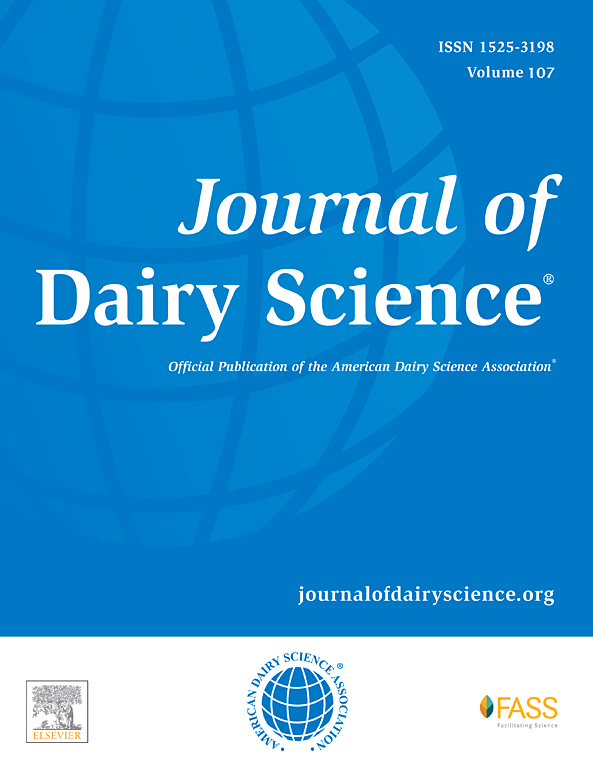根据泌乳奶牛在牛群中的社会等级位置,时间性限水对其饮水行为和时间预算的影响。
IF 4.4
1区 农林科学
Q1 AGRICULTURE, DAIRY & ANIMAL SCIENCE
引用次数: 0
摘要
在奶牛场,挤奶操作会暂时限制奶牛获得饮用水。本研究探讨了不同类型的临时饮水限制(类似于牧场上常见的限制)会如何影响奶牛的个体行为和生理脱水状态,以及这些影响是否会因奶牛在群体中的社会等级而有所不同。采用4 × 4拉丁方阵设计,对4组10头泌乳奶牛进行了四种处理(CTRL = 自由进入饮水器和饲喂围栏;HL = 早晚挤奶后在饲喂围栏前锁头2小时;D2H = 挤奶后自由进入饲喂围栏2小时且不能饮水;D4H = 挤奶后自由进入饲喂围栏4小时且不能饮水)。每个处理期持续 1 周。奶牛饲养在一个自由堆放的牛舍中,每组奶牛的围栏都配备了 1 个电子饮水器、10 个独立饲喂器和 2 个摄像头。奶牛的社会支配等级采用归一化的戴维评分,该评分是根据视频检测到的每栏饮水器的替换情况计算得出的。在每个处理期的最后 4 天,使用相互连接的饮水器测量饮水行为,并使用加速度计测量进食、闲置和躺卧时间。在每个处理期的第 6 天,在早晚挤奶期间,分别采集血液和牛奶样本,以分析脱水和牛奶成分的生物指标。奶牛的日饮水量不受社会支配地位或处理类型的影响。HL、D2H和D4H处理期间的饮水率和饮水次数均高于CTRL处理期间,而D4H处理期间的饮水时间低于CTRL处理期间。在限水期结束时,即在HL处理中的1000小时、D2H处理中的1100小时、D4H处理中的1200小时和1300小时,每小时的卧地时间减少,而在CTRL处理中没有观察到这种情况,这可解释为奶牛不适的迹象。在早晨挤奶前采集的血液中,D4H处理的血细胞比容水平低于HL处理。傍晚挤奶前采集的血液中,D4H处理的肌酐浓度低于D2H处理,优势奶牛的差异大于劣势奶牛。在两次挤奶中,HL、D2H 和 D4H 处理的牛奶凝固点均高于 CTRL 处理,这表明牛奶被稀释。与其他社会类别相比,在D4H处理中,从属奶牛每天去饮水器的次数多于CTRL处理,但在D2H处理中,与CTRL处理相比,从属奶牛的饮奶阵列持续时间或阵列中饮奶中断的持续时间没有差异。总体而言,尽管有临时饮水限制,但当奶牛能够使用动物福利指南建议的饮水器数量时,它们仍能保持饮水量。尽管如此,它们的闲置和躺卧时间似乎受到了干扰。本文章由计算机程序翻译,如有差异,请以英文原文为准。
Effect of temporal water restrictions on drinking behavior and time budget in lactating dairy cows according to their position in the social hierarchy within the herd
On dairy farms, milking practices can temporarily restrict cows from accessing drinking water. This study examined how different types of temporary water restriction, similar to those commonly encountered on farms, may affect the individual behavior and physiological dehydration status of cows and whether these effects could differ according to the cow's position in the social hierarchy of the group. Four treatments were applied (CTRL = free access to the drinker and feed fence, HL = 2 h of headlock at the feed fence after morning and evening milking, D2H = free access to the feed fence and no access to water for 2 h after milking, and D4H = free access to the feed fence and no access to water for 4 h after milking) to 4 groups of 10 lactating dairy cows using a 4 × 4 Latin square design. Each treatment period lasted 1 wk. The cows were housed within a freestall barn, and each group was in a pen equipped with 1 electronic drinker, 10 individual feeders, and 2 cameras. Cow social dominance hierarchies were characterized using normalized David's scores, which were calculated from video-detected replacements at each pen's drinker. During the last 4 d of each treatment period, drinking behavior was measured using interconnected drinkers, and eating, idle, and lying times were measured using accelerometers. On d 6 of each treatment period, during the morning and evening milkings, blood and then milk samples were collected to analyze bioindicators of dehydration and milk composition, respectively. The daily water intake of cows was unaffected by either social dominance or treatment type. Drinking rate and drinking bout frequency were higher during the HL, D2H, and D4H treatments than during the CTRL treatment, and drinking time was lower during the D4H treatment than during the CTRL treatment. Hourly lying time decreased at the end of the water restriction periods, that is, at 1000 h in HL, at 1100 h in D2H, and at 1200 and 1300 h in D4H, which was not observed in CTRL, which could be interpreted as a sign of cow discomfort. For blood collected before the morning milking, hematocrit levels were lower in the D4H treatment than in the HL treatment. For blood collected before the evening milking, creatinine concentrations were lower in the D4H treatment than in the D2H treatment, with a greater difference seen for dominant cows than for subordinate cows. For both milkings, milk freezing point was higher in the HL, D2H, and D4H treatments than in the CTRL treatment, indicating dilution. In contrast to the other social categories, subordinate cows made more daily visits to the drinker during the D4H treatment than during the CTRL treatment but displayed no differences in drinking bout duration or the duration of drinking interruptions within bouts in the D2H treatment compared with the CTRL treatment. Overall, cows were able to maintain their water intake despite the temporary water restrictions when they had access to the number of drinkers recommended by animal welfare guidelines. That said, their idle and lying time appeared to be disturbed.
求助全文
通过发布文献求助,成功后即可免费获取论文全文。
去求助
来源期刊

Journal of Dairy Science
农林科学-奶制品与动物科学
CiteScore
7.90
自引率
17.10%
发文量
784
审稿时长
4.2 months
期刊介绍:
The official journal of the American Dairy Science Association®, Journal of Dairy Science® (JDS) is the leading peer-reviewed general dairy research journal in the world. JDS readers represent education, industry, and government agencies in more than 70 countries with interests in biochemistry, breeding, economics, engineering, environment, food science, genetics, microbiology, nutrition, pathology, physiology, processing, public health, quality assurance, and sanitation.
 求助内容:
求助内容: 应助结果提醒方式:
应助结果提醒方式:


